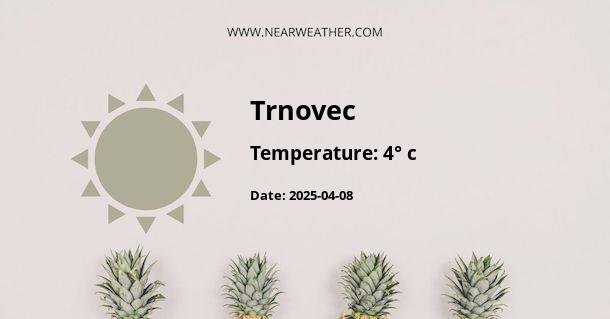Understanding Trnovec's Climate and Weather
Trnovec, a picturesque location in Croatia, is characterized by a climate that reflects the transitional nature between continental and Mediterranean influences. This creates a unique blend of weather patterns, offering residents and visitors a distinct experience throughout the year. To gain a deeper understanding of Trnovec's climate and its implications, we will delve into the different seasonal weather trends, providing insights supported by statistics and expert opinions.
Geographical Influence on Trnovec's Climate
Trnovec's position geographically plays a crucial role in defining its climate. Being inland, the region experiences larger variations between summer and winter temperatures compared to the Adriatic coast. This distinction in climatic conditions is due to the absence of the moderating influence of the sea.
"The climate in Trnovec, while generally mild, can exhibit significant seasonal variations that should be taken into account for activities such as agriculture, tourism, and local lifestyle," says Dr. Ivana Horvat, a climatologist specializing in the Croatian climate.
Seasonal Climate and Weather Patterns
Below is a breakdown of Trnovec’s climate by season, providing a detailed picture of what one can expect throughout the year:
Spring
- Temperature: Rising gradually from March with average highs of 12°C to May with averages nearing 21°C.
- Precipitation: Spring tends to be wet, with April often being the rainiest month of the year.
- Weather events: Occasional thunderstorms and rapid weather changes can occur.
Summer
- Temperature: Warm to hot, often exceeding 30°C in July and August during heatwaves.
- Precipitation: Although summers are generally drier, sporadic heavy storms, typical for continental climates, may occur.
- Weather events: Heat waves and occasional thunderstorms are not uncommon, accounting for the majority of summer rainfall.
Autumn
- Temperature: A gradual cooling begins, with September averages around 20°C, cooling down to around 8°C by November.
- Precipitation: Rainfall increases as the season progresses, with fog becoming a more common occurrence.
- Weather events: The frequency of rainy days increases towards winter, with November often being particularly wet and cloudy.
Winter
- Temperature: Coldest months are January and February, with averages around 0°C to 3°C but can drop below freezing.
- Precipitation: Snow is possible but not overly abundant; however, it can occasionally lead to disruptions when it does fall.
- Weather events: Frost, fog, and icy conditions are common, particularly in the mornings and nights.
These seasonal observations are based on long-term meteorological data and can vary from year to year. However, they provide a reliable guide for expectations when visiting or residing in Trnovec.
Monthly Weather Averages
Let's analyze the monthly weather averages for a comprehensive overview of Trnovec's climate:
| Month | Average High (°C) | Average Low (°C) | Precipitation (mm) | Sunshine Hours |
|---|---|---|---|---|
| January | 3 | -2 | 35 | 2 |
| February | 6 | 0 | 30 | 3 |
| March | 12 | 3 | 40 | 4 |
| April | 16 | 7 | 55 | 6 |
| May | 21 | 11 | 65 | 7 |
| June | 25 | 15 | 75 | 8 |
| July | 27 | 17 | 70 | 9 |
| August | 27 | 16 | 60 | 9 |
| September | 23 | 13 | 55 | 7 |
| October | 16 | 8 | 70 | 5 |
| November | 10 | 3 | 80 | 3 |
| December | 5 | -1 | 50 | 2 |
This table provides an overview of average temperatures and precipitation, offering a visual guide to the weather throughout the year. Note that sunshine hours reflect the typical exposure one can expect, which influences outdoor activities.
Extreme Weather and Climate Events
Trnovec, like many other regions, is not immune to extreme weather events. In recent years, fluctuations in global weather patterns have resulted in anomalies such as:
- Unusually high temperatures during summer months.
- Intense thunderstorms leading to flash floods.
- Atypical cold spells in winter with increased snowfall.
These events, while not common, can have significant impacts on the region's infrastructure, agriculture, and day-to-day life.
Climate Change Considerations
According to research conducted by Croatian meteorologists and climate scientists, climate change is expected to influence the traditional patterns observed in Trnovec. Predictions suggest an increase in average temperatures and a possible rise in the frequency of extreme weather events. This underscores the importance of taking into account long-term climate projections when planning for the future.
Planning Your Visit Based on Weather
When planning a visit to Trnovec, the weather plays a critical role in determining the best time to travel. If you are looking to enjoy the warm, pleasant climate without the extremes of summer heat, late spring or early autumn are ideal. For those who wish to experience the full warmth of the Croatian inland summer, July and August are the months to visit. Winters can be cold, but they also offer a different kind of beauty, with the potential for snow-capped landscapes.
In summary, Trnovec offers a diverse climate with distinct seasonal changes. Understanding these patterns allows for better preparation and appreciation of the region's beauty, regardless of when you choose to visit.
A - Trnovec's Latitude is 46.385830 & Longitude is 16.311939.
A - Weather in Trnovec is 12° today.
A - Climate Conditions in Trnovec shows clear sky today.
A - Humidity in Trnovec is 74% today.
A - Wind speed in Trnovec is 4.14 km/h, flowing at 227° wind direction. today.
